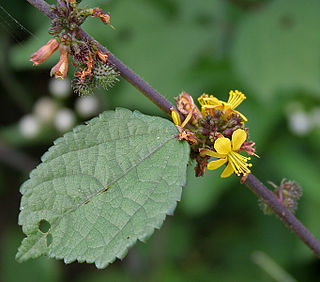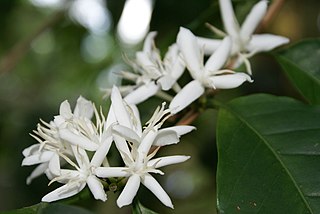
Kraussia is a flowering plant genus in the family Rubiaceae. Apart from a species in Socotra, they are native to continental Africa. The type was described from a plant collected by Dr. F. Krauss near Durban. It is differentiated from Tricalysia and Empogona by the ovule arrangement inside the ovary cells. The genus contains between 4 and 10 species, including:

Leptactina is a genus of flowering plants in the family Rubiaceae. There are about 27 species. They are all native to sub-Saharan Africa, where most occur in rainforest habitat.

Polysphaeria is a genus of plants in the family Rubiaceae, and its native range is Madagascar and Tropical Africa. It contains the following 22 species according to Plants of the World Online:

Sericanthe is a genus of flowering plants in the family Rubiaceae. It is found in tropical and subtropical Africa. The genus was described by Elmar Robbrecht in 1978 based on the species in Neorosea, except for the type species, Neorosea jasminiflora, which went to Tricalysia. Bacterial leaf nodules are found in most of the species and the endophytic bacteria have been identified as Burkholderia.

Tricalysia is a genus of flowering plants in the family Rubiaceae. The genus is found in tropical and southern Africa and on the islands in the Western Indian Ocean.

Vangueria is a genus of flowering plants in the family Rubiaceae. The genus is named for Voa vanguer, as V. madagascariensis is known in Malagasy.

Athrixia is a genus of flowering plants in the family Asteraceae. It includes 15 species of perennial herbs or shrubs native to eastern and southern Africa, ranging from Ethiopia to South Africa including Madagascar.

Triumfetta is a genus of plants in the family Malvaceae. Burbark is a common name for plants in this genus.
Cuviera is a genus of flowering plants in the family Rubiaceae native to tropical Africa. It was originally described by Augustin Pyramus de Candolle in 1807 and is named after the French naturalist Georges Cuvier.
Argocoffeopsis is a genus of flowering plants in the family Rubiaceae. It is found in tropical Africa. They are lianas, climbing by means of horizontal or recurved lateral branches, or sometimes shrubs. Their papery bark is grey or brown and peeling off.

Coffeeae is a tribe of flowering plants in the family Rubiaceae and contains about 333 species in 11 genera. Its representatives are found in tropical and southern Africa, Madagascar, the western Indian Ocean, tropical and subtropical Asia, and Queensland.









